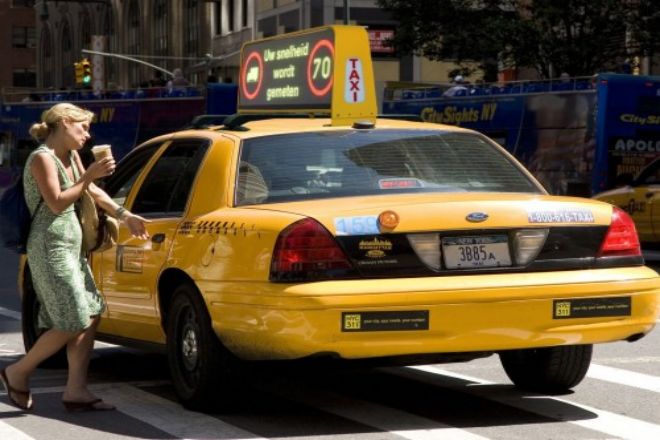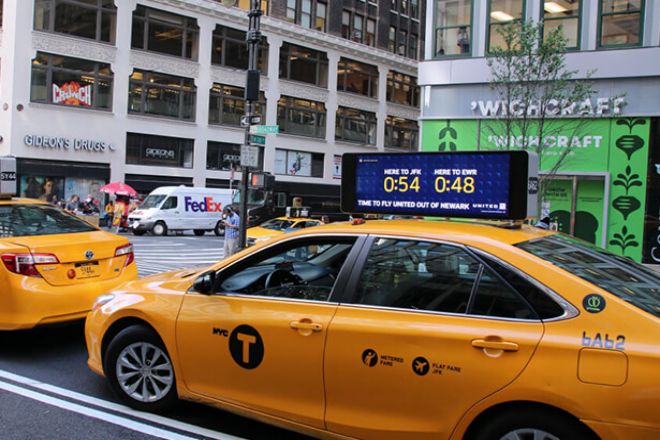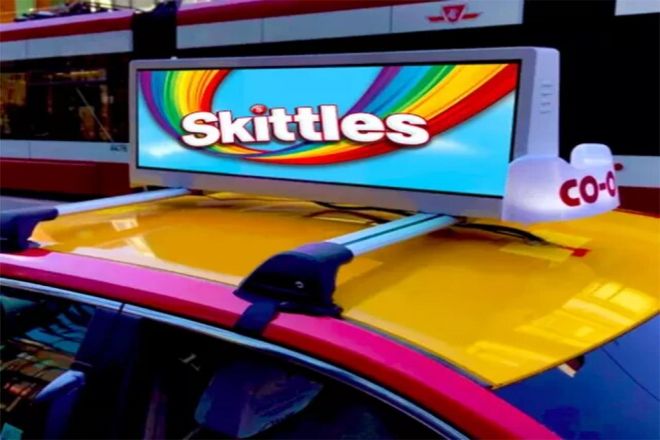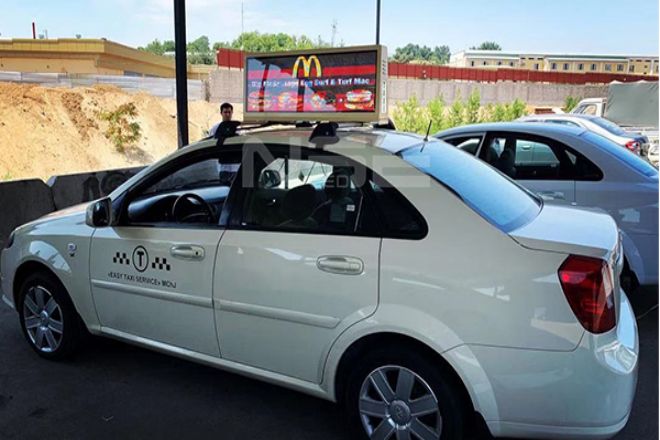Introduction

As an important part of urban public transportation, LED taxi screens not only provide passengers with convenient traffic information but also become an important window for displaying the city’s image.
However, as the number of LED taxi screens continues to increase, its energy consumption problem has gradually become prominent.
The power consumption of LED taxi screens is not only related to the operating costs of the equipment but also closely related to the energy consumption and environmental protection of society as a whole.
Therefore, how to accurately calculate the power consumption of LED taxi screens and propose effective energy-saving optimization strategies on this basis has become an urgent problem to be solved.
This article will give you a detailed understanding of the power consumption of LED taxi screens.
1. Definition of LED taxi screen
The LED taxi screen is a mobile LED electronic display device loaded on the taxi body. It is a communication media for vehicle-mounted advertising machines.
The LED taxi screen is usually installed on the top or rear window of the taxi, powered by a dedicated power supply, and receives and outputs data to the dot matrix LED unit board through the control card, thereby controlling the on and off of the dot matrix to display text, pictures, animations and Videos and other content.
This kind of screen has the advantages of high brightness, far-sighted vision, clear images, bright colors, good stability, low power consumption, high light efficiency, and long life.
The LED taxi screen is not only an advertising platform but can also display news reports and other information. Some advanced LED taxi screens also have built-in GPS modules, which can intelligently switch advertising content based on location and traffic information.
Therefore, LED taxi screens have broad application prospects in the fields of urban transportation and advertising media.
2. What does the power consumption of LED taxi screens include?

1). LED chip power consumption
The LED chip is like the heart of the LED taxi screen. Without it, the screen cannot emit light. Simply put, its power consumption is the power consumed by the LED chip when it is working. The power consumed is similar to the power consumed by light bulbs in our homes, except that the LED chip consumes less power and is more efficient.
To calculate the power consumption of an LED chip, we only need to know the current it passes and the voltage it endures when it is working. It’s like at home. To know the power consumption of a light bulb, we only need to know its current and voltage. Similarly, the power consumption of the LED chip can also be calculated by measuring these two values.
In addition, manufacturers will also tell us the power consumption of LED chips in their product manuals or technical specifications. In this way, when we choose LED taxi screens, we can compare the power consumption performance of different products based on this information so as to choose more energy-saving products.
2). Power consumption of the driving circuit
The driver circuit is like the “translator” of the LED taxi screen. Its job is to “translate” the electrical energy provided by the power supply into a language that the LED chip can understand – that is, the appropriate current and voltage. This “translation” process is not perfect, and part of the power will be “consumed” during this process. This is the power consumption of the drive circuit.
If it works smoothly and smoothly, it will consume very little power. On the contrary, if the work is time-consuming and laborious, it will consume relatively high power consumption.
3). Power consumption of the cooling system
The heat dissipation system is like the “bodyguard” of the LED taxi screen. Its job is to help the LED chip and drive circuit “cool down” and ensure that they will not “sick” or “strike” due to overheating. Imagine that in the summer, in order to keep ourselves cool, we may turn on fans or air conditioners. These devices consume electricity when working.
The same is true for the cooling system. The fans, heat sinks, and other components inside it will also consume power when working. This is the power consumption of the cooling system.
Although the power consumption of the cooling system may not be very large compared to the LED chip and drive circuit, it is also part of the overall power consumption of the LED taxi screen.
If the power consumption of the cooling system is too high, it will not only increase the operating cost of the LED taxi screen but may also affect its stability and service life.
3. LED taxi screen power consumption calculation

When many people buy LED taxi screens, they usually do not buy just one but buy multiple ones to form a large screen. Therefore, when calculating the power consumption of the entire LED taxi screen system, we need to consider the total power consumption of all screens.
The simplest calculation formula is:
Total power consumption = number of LED taxi screens * (LED chip power consumption + cooling system power consumption + driving circuit power consumption)
This formula provides a basic estimation method, allowing us to roughly understand the power consumption level of the entire LED taxi screen system. However, it is important to note that this is only a basic estimate, and actual conditions may vary due to a variety of factors.
For example, ambient temperature is a very important factor. If LED taxi screens are installed outdoors, they may be exposed to extreme temperature conditions, which will affect the working efficiency of the LED chip, drive circuit, and cooling system, thereby affecting the power consumption of the entire system.
In addition, working conditions, such as the usage time and brightness settings of LED taxi screens, will also affect power consumption.
Therefore, in practical applications, we need to make more accurate estimates of power consumption based on specific installation situations, usage environments, and working conditions.
It may also be necessary to conduct field power consumption tests in conjunction with some professional power consumption measurement equipment to ensure that our estimates are as accurate as possible.
4. What measures can be taken to reduce the power consumption of LED taxi screens?
- Brightness adjustment:
Adjust the brightness of the LED taxi screen in a timely manner according to actual needs and ambient brightness. During periods when high brightness is not required, such as at night or during low-traffic periods, the brightness can be reduced to reduce energy consumption.
At the same time, an automatic brightness adjustment system is used to adjust the brightness of the LED taxi screen automatically according to changes in ambient brightness to achieve better energy-saving effects.
- Time plan control:
Time plan control is another effective energy-saving strategy. You can set the opening and closing time schedule of the LED taxi screen to ensure that the display is turned off in time when there is no need to display content.
For example, during non-working hours or low-traffic periods, you can turn off the LED taxi screen to reduce unnecessary energy consumption. This strategy can be adjusted according to actual needs, which not only ensures the normal use of the LED taxi screen but also achieves energy savings.
- Optimize power supply and circuit design:
You can also optimize power supply and circuit design. First, you can use efficient LED modules and drivers. These components have lower power consumption and higher conversion efficiency, helping to reduce energy consumption.
Secondly, you can optimize the power supply and circuit design, improve power conversion efficiency, and reduce internal circuit power consumption. These optimization measures can significantly reduce the energy consumption of LED taxi screens and improve overall operating efficiency.
- Use an efficient heat dissipation system:
A scientifically designed heat dissipation system ensures that the LED taxi screen can maintain a lower temperature during high-load operation and reduce additional energy consumption due to overheating.
- Software optimization:
Through software optimization, unnecessary calculations and renderings are reduced, and the overall power consumption of the system is reduced.
- Multi-level grayscale correction technology:
Multi-level grayscale correction technology is an effective energy-saving measure. By using this technology, you can reduce color distortion and brightness fluctuations and improve display quality while reducing overall power consumption. This technology can accurately control the brightness of the LED taxi screen based on actual needs and ambient brightness, ensuring energy saving while ensuring the display effect.
- Intelligent control system:
The intelligent control system is adopted to realize remote monitoring and management, ensuring that the LED taxi screen is turned on only when needed, reducing unnecessary energy consumption.
- Regular maintenance and inspection:
Regular maintenance and inspection of LED taxi screens to ensure their normal operation and efficient work. Clean the surface of the LED taxi screen to remove dust and stains to ensure smoother light transmission and reduce energy consumption.
5. The relationship between the energy consumption of LED taxi screens and taxis

There is indeed a close correlation between the energy consumption of LED taxi screens and taxis. This correlation comes from the fact that the display screen is installed directly on the roof of the taxi. This relationship is specifically reflected in the following aspects:
- Frequency and duration of use:
The high mobility of taxis means that the frequency and duration of use of LED taxi screens may be relatively high. Whenever a taxi is in operation, the LED taxi screen on its top may be in working condition, thus continuously consuming power.
- Display content update:
LED taxi screens may need to frequently update the display content to display different advertisements, information, or promotional content.
Such frequent updates may increase the energy consumption of the system, especially in situations where high brightness and fast switching are required.
- Environmental adaptability:
Taxis usually need to operate in various environmental conditions, including high temperature, low temperature, humidity, etc. These environmental conditions may affect the working efficiency and energy consumption of LED taxi screens. For example, high temperatures can cause equipment to overheat, thereby increasing energy consumption and reducing equipment life.
- Equipment quality and maintenance:
The LED taxi screen on the top of the taxi may be affected by weather, road conditions, and other external factors, resulting in equipment damage or performance degradation.
In order to ensure normal operation and extend the service life of the equipment, regular maintenance and replacement may be required. These maintenance activities may also be related to energy consumption.
Conclusion
To sum up, there is a close correlation between the energy consumption of LED taxi screens and taxis. Regular equipment maintenance and upkeep are crucial to ensure efficient operation of the equipment and reduce energy consumption.
If you want to know more about LED taxi screens, please get in touch with us!
